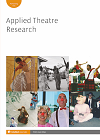
Full text loading...
 , Stig A. Eriksson2
, Stig A. Eriksson2
In this practice-oriented article, each author has found an example in their national contemporary literary legacy to be explored through educational drama approaches. One is a short story (and a one-act play version of the story) by Lao She, China; the other is a short story by Tor Åge Bringsværd, Norway. Both stories are about experiences on train journeys and the article presents ideas for how to use them in drama pedagogical settings. Each author contextualizes their drama approach in terms of current public curriculum policies relevant to aesthetic education and drama education in each country, and theory from the field literature.

Article metrics loading...

Full text loading...
References


Data & Media loading...

Publication Date:
https://doi.org/10.1386/atr_00069_1 Published content will be available immediately after check-out or when it is released in case of a pre-order. Please make sure to be logged in to see all available purchase options.